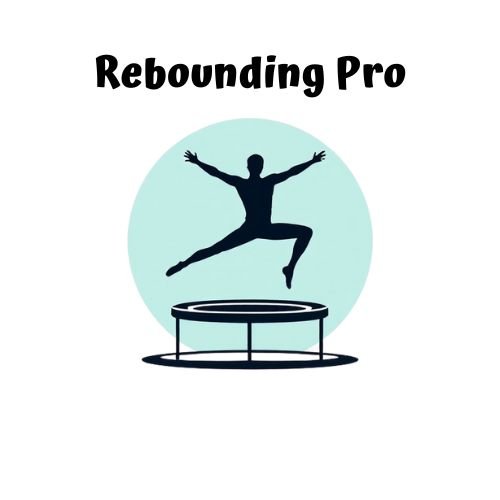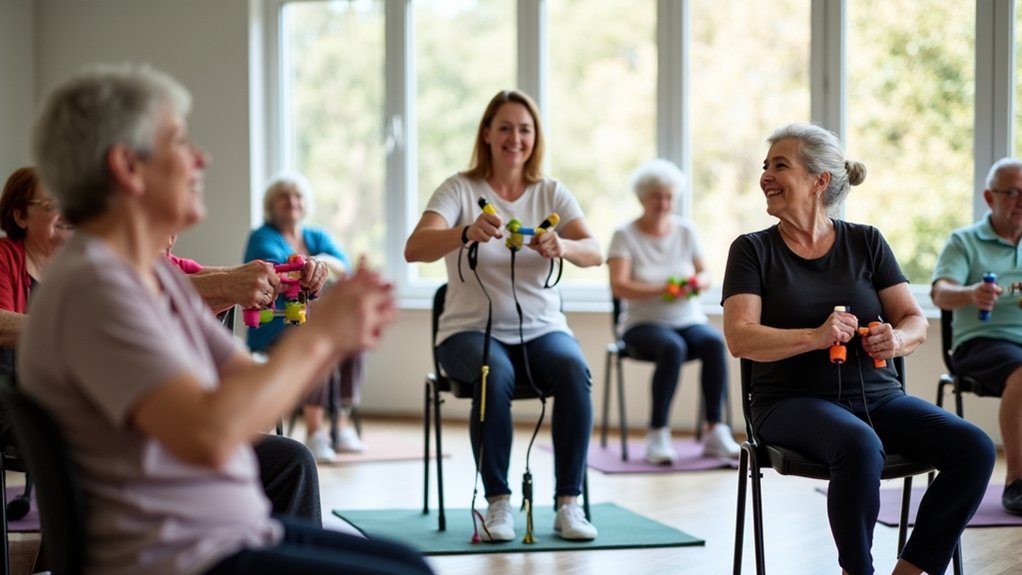Lymphatic drainage helps manage the significant water retention during pregnancy caused by hormonal changes and increased blood volume. You’ll experience reduced swelling in your ankles, feet, and hands through gentle techniques like rebounding (mini-trampoline bouncing) and manual massage. These methods stimulate your lymphatic system, improve circulation, enhance immune function, and provide mental health benefits by reducing stress and anxiety. The right approach can transform your pregnancy comfort while supporting your changing body through each trimester.
Why Your Body Retains Water During Pregnancy

Five key mechanisms explain why your body holds extra fluid during pregnancy.
Rising progesterone levels relax your blood vessels and increase their permeability, allowing fluid to leak into surrounding tissues. This effect intensifies in your third trimester as hormone levels peak.
Your blood volume expands considerably to nourish your growing baby, peaking around weeks 28-32. This increase raises pressure within your circulatory system, pushing more fluid into tissues.
As your uterus grows, it compresses major veins, particularly in your pelvic region, impeding blood return to your heart and causing fluid to accumulate in your legs and feet. The enlarging uterus specifically affects blood flow from the legs back to the heart, creating a backup of fluid in the lower extremities.
Your diet matters too—excessive salt consumption worsens water retention.
Meanwhile, your body activates complex systems like renin-angiotensin-aldosterone to manage these dramatic fluid shifts.
The Science Behind Lymphatic Drainage for Expectant Mothers
While your body naturally accumulates fluid during pregnancy, the lymphatic system plays an essential role in managing this excess. This network of vessels helps transport fluid from tissues back into your bloodstream, but pregnancy’s hormonal changes and weight gain can impair its function.
Lymphatic drainage techniques, particularly the Godoy & Godoy method, work by gently stimulating this system to reduce swelling. Research confirms its effectiveness, with studies showing statistically significant reductions in leg volume (from 2856.4g to 2812.0g) after treatment.
Gentle lymphatic techniques like Godoy & Godoy effectively reduce pregnancy swelling, with studies documenting measurable leg volume reductions.
The technique is especially beneficial during your fifth to eighth months when fluid retention peaks. These treatments help alleviate common pregnancy discomforts like peripheral oedema caused by the weight of the gravid uterus on your inferior vena cava.
Unlike deep tissue massage, lymphatic drainage uses gentle, specialized movements that are safe during pregnancy when performed by trained therapists, making it an ideal complement to your prenatal care routine.
Rebounding: A Safe Way to Stimulate Lymphatic Flow

Among the gentlest yet most effective techniques for lymphatic stimulation during pregnancy, rebounding stands out as an accessible option you can perform at home. This gentle bouncing activates your lymphatic system through G-force changes, tripling white blood cell production within minutes. The low impact activity makes rebounding particularly suitable for pregnant women as it reduces 87% of impact shock compared to exercising on hard surfaces.
| Rebounding Benefits | Safety Considerations |
|---|---|
| Full lymphatic flush in just 2 minutes | Consult healthcare provider first |
| Enhanced immune cell production | Maintain low impact, gentle bounces |
| Pelvic floor strengthening | Adjust as pregnancy progresses |
| Systemic detoxification | Stop if dizziness or discomfort occurs |
For best results, incorporate short 2-5 minute sessions throughout your day on a quality rebounder with tension control. Stay hydrated after sessions to support toxin elimination, and always maintain proper posture to maximize the gravitational lymphatic pull.
Managing Pregnancy Edema Through Gentle Bouncing Exercise
Gentle bouncing on a mini-trampoline can effectively reduce pregnancy-related swelling by stimulating your lymphatic system and improving circulation.
You’ll want to maintain proper form by keeping knees slightly bent, holding support rails, and limiting your bounces to small, controlled movements rather than high jumps. This gentle exercise can be especially beneficial in the third trimester when edema typically becomes more pronounced.
These circulation-boosting patterns work best when you incorporate simple variations like heel lifts, gentle marching, or side-to-side movements for just 5-10 minutes daily with your healthcare provider’s approval.
Safe Bouncing Techniques
When pregnancy edema affects your comfort and mobility, bouncing exercises can offer surprising relief. These gentle movements stimulate your lymphatic system, helping reduce swelling throughout your body.
Before starting, consult your healthcare provider and verify you’re using the correct ball size. Always have support nearby to prevent falls.
Begin with slow hip rotations while seated, then incorporate gentle bounces combined with deep breathing. Side-to-side hip sways further enhance circulation. Consider ending your bouncing session with legs-up-the-wall pose for additional relaxation and improved blood flow.
Limit sessions to 10-15 minutes and stay hydrated throughout. For best results, pair bouncing with other remedies like elevating your feet, wearing compression socks, and applying cool water to swollen areas.
Monitor your swelling before and after exercises to track progress, and always adjust based on your comfort level. Stop immediately if you experience any discomfort.
Circulation-Boosting Movement Patterns
The strategic combination of specific movement patterns can dramatically boost circulation and reduce pregnancy-related swelling.
Gentle bouncing stimulates muscle contractions in your legs and pelvis, promoting venous and lymphatic return while preventing fluid stagnation in your lower extremities.
To maximize benefits without stressing your joints:
- Perform seated bouncing for 30-60 seconds while maintaining proper posture, then shift to hip circles that engage your core and pelvic floor.
- Combine ankle pumps with your bouncing routine to activate calf muscle venous pumps.
- Alternate between 2-3 minute sessions initially, gradually increasing duration as comfort allows.
Using a birthing ball made from anti-burst materials provides essential stability and safety during these circulation-boosting exercises.
Remember to hydrate thoroughly and elevate your legs after these exercises for best edema reduction.
Monitor your body’s response and adjust intensity based on comfort.
How Rebounding Reduces Swelling in Ankles, Feet and Hands

Rebounding offers a powerful solution for pregnancy-related swelling by directly influencing your body’s lymphatic system.
When you bounce on a mini trampoline, the changing gravitational forces open one-way lymphatic valves, enhancing fluid circulation throughout your body.
This gentle bouncing motion specifically targets common swelling areas like your ankles, feet, and hands by improving lymph flow.
The rhythmic up-and-down movement creates a pumping effect that helps flush excess fluid and toxins from your extremities.
For best results, aim for 3-5 low-intensity sessions weekly, with just 10 minutes per session providing noticeable benefits.
You’ll need to modify your rebounding technique as your pregnancy progresses, and always consult your healthcare provider first to ascertain this approach aligns with your specific pregnancy needs.
The exercise provides a gentle yet effective way to stimulate white blood cell production, which further supports your immune system during pregnancy.
Relieving Pregnancy-Related Carpal Tunnel Through Movement
You’ll find relief from pregnancy-related carpal tunnel syndrome through specific movement techniques that target wrist compression.
Gentle stretching exercises that extend your wrists and fingers can decompress the median nerve, reducing the tingling and numbness you’re experiencing.
Regular hand circles and finger spreading movements help stimulate lymphatic drainage around the carpal tunnel area, allowing excess fluid to move away from the compressed nerves. Wearing wrist splints at night can provide additional support and prevent worsening of symptoms when you’re not actively exercising.
Wrist Compression Relief
Swollen wrists and numbness in the hands plague up to 60% of expectant mothers as pregnancy progresses, often manifesting as carpal tunnel syndrome due to increased fluid retention.
Targeted compression is your ally in combating this discomfort, as it notably reduces interstitial fluid buildup that causes nerve pressure.
For maximum relief, combine compression with movement techniques that enhance lymphatic drainage:
- Wear adjustable wrist braces during daily activities, ensuring they maintain a neutral position without restricting finger mobility.
- Perform gentle wrist rotations and finger stretches hourly to promote synovial fluid movement.
- Elevate your hands whenever possible, leveraging gravity to reduce inflammation.
Incorporating 15-minute heat sessions before applying compression can enhance circulation and prepare tissues for more effective lymphatic drainage. FEATOL wrist braces with two adjustable straps allow for personalized comfort while maintaining therapeutic compression levels needed during pregnancy.
Nerve Decompression Techniques
The gentle art of nerve mobilization offers pregnant women significant relief from carpal tunnel symptoms without medication. By incorporating specific movements that encourage nerve gliding and fluid drainage, you’ll reduce compression on the median nerve while improving circulation. Performing these exercises and stretches before bedtime can provide significant nighttime relief when symptoms often worsen.
| Technique | Benefit |
|---|---|
| Nerve gliding | Improves nerve mobility, reduces compression |
| Elevated hand exercises | Combines drainage with motion for dual benefits |
| Proximal stroking | Encourages lymphatic flow away from wrist |
| Contrast therapy | Reduces inflammation and desensitizes nerves |
| Wrist-neutral positioning | Prevents additional compression during daily tasks |
Practice these techniques with your hands elevated above heart level whenever possible. Remember to avoid massage toward fingertips, which can worsen fluid retention. Instead, focus on gentle movements that activate the muscle pump while maintaining pain-free ranges of motion.
Safe Rebounding Techniques for Each Trimester
Rebounding during pregnancy requires three distinct approaches tailored to each trimester’s unique physiological demands. Always consult your OB-GYN before starting any rebounding routine and keep your heart rate below 140 bpm throughout your pregnancy.
In your first trimester, focus on low-impact movements with 5-10 minute sessions. Self-massage techniques can complement rebounding by providing lymphatic drainage benefits that help reduce swelling in the legs.
Second trimester requires reduced intensity with rhythmic, controlled bouncing while maintaining proper posture.
By your third trimester, consider seated options with handrail support and limit sessions to 2-3 times weekly.
- Use anti-slip mats and supportive footwear to prevent falls as your center of gravity shifts
- Pair rebounding with pelvic floor exercises to strengthen muscles before and after sessions
- Monitor for symptoms like cramping or dizziness and stop immediately if they occur
Beyond Physical Relief: Mental Health Benefits of Lymphatic Exercise
While physical benefits of lymphatic exercises during pregnancy receive considerable attention, their profound impact on mental health often goes unrecognized.
These gentle movements stimulate your parasympathetic nervous system, reducing stress and anxiety while promoting emotional stability through decreased cortisol levels.
Embrace gentle lymphatic exercises to activate relaxation pathways and balance your pregnancy hormones for emotional wellbeing.
You’ll likely notice improved mental clarity as fluid retention-related brain fog diminishes. The rhythmic nature of lymphatic exercises triggers your relaxation response, alleviating mood swings common during pregnancy.
Additionally, enhanced serotonin and dopamine activity from improved fluid circulation can considerably boost your mood.
Beyond immediate relief, regular lymphatic exercise strengthens your emotional resilience by supporting the gut-brain axis and reducing inflammatory cytokines linked to prenatal depression. Practicing these techniques can help remove waste and toxins from the body while supporting your immune system during this crucial time.
Many women report deeper body awareness and improved maternal-fetal bonding through this mindful practice.
Combining Rebounding With Manual Drainage for Maximum Results
You’ll get the most from your lymphatic health routine by combining gentle rebounding with manual drainage techniques.
When practicing at home, start with 5-10 minutes of gentle bouncing on a pregnancy-safe mini-trampoline with a stability bar, followed by self-massage lymphatic drainage strokes. This combination helps maintain fluid balance in the body while reducing pregnancy-related swelling and water retention.
Always check that your equipment has non-slip feet, a stable frame, and appropriate weight capacity for pregnancy use.
Low-impact Bounce Benefits
For pregnant women seeking relief from swelling and improved circulation, combining gentle rebounding with manual lymphatic drainage creates a powerful therapeutic duo.
The low-impact nature of mini-trampoline exercises offers significant benefits while protecting your joints during pregnancy.
When you incorporate gentle bouncing into your routine, you’ll experience:
- Enhanced lymphatic flow as each bounce opens and closes valves, flushing toxins more effectively than MLD alone
- Increased energy levels and improved immune function through better white blood cell circulation
- Reduced pregnancy swelling with minimal strain on your changing body
Make sure to work with trained practitioners who understand that MLD involves gentle, rhythmic movements specifically designed to stimulate lymph flow without causing discomfort.
Remember to modify your rebounding technique as your pregnancy progresses, keeping movements gentle and controlled.
Always get medical clearance before starting this combination approach, especially if you’re experiencing complications or high-risk factors.
Home Practice Guidelines
Creating a comfortable home practice environment is essential for maximizing the benefits of combined rebounding and manual lymphatic drainage during pregnancy.
Choose a quiet space with soft lighting and comfortable temperature to enhance relaxation and focus during your sessions.
For ideal results, start with manual drainage techniques to clear blockages before gentle rebounding.
Apply light strokes following natural lymphatic pathways, then shift to low-impact bouncing with proper posture.
Afterward, perform another round of manual drainage to boost lymph flow further.
Remember to synchronize your breathing with both techniques and gradually increase duration as your comfort allows.
Monitor your progress and always listen to your body, stopping immediately if you experience pain.
Consult with healthcare providers before beginning this practice, especially if you have pre-existing conditions.
Equipment Safety Checklist
Safety remains paramount when combining rebounding with manual lymphatic drainage during pregnancy. Before starting this powerful combination therapy, verify your equipment meets specific safety standards.
Your rebounder should feature a non-slip surface with textured matting, sturdy handrails for stability, and weight capacity that exceeds your pregnancy weight plus a safety margin.
For ideal results while maintaining safety:
- Schedule MLD first, followed by gentle rebounding to prevent fluid overload
- Limit rebounding to 20-minute sessions and MLD to 45 minutes maximum
- Consider seated rebounding during your third trimester
Always work with certified MLD practitioners who understand pregnancy-specific techniques and contraindications. Remember that pressotherapy uses an air pressure machine to provide similar benefits but requires professional administration.
Monitor your essential signs before and after sessions, and maintain proper hydration throughout the process to maximize lymphatic benefits.
Postpartum Recovery: Rebounding After Baby Arrives
While childbirth marks the end of pregnancy, it signals the beginning of a critical recovery journey for new mothers. Your body needs support to heal efficiently, and lymphatic drainage can be a powerful ally during this time.
After delivery, you’ll likely experience swelling, fluid retention, and muscle discomfort. Lymphatic drainage helps speed up your recovery by enhancing circulation and reducing these symptoms. If you’ve had a c-section, it’s particularly beneficial for reducing swelling and alleviating postoperative pain.
Gentle lymphatic drainage becomes your body’s trusted ally, efficiently reducing postpartum swelling while supporting your natural healing process.
Beyond physical healing, lymphatic drainage offers emotional benefits during this adjustment period, helping reduce anxiety and promoting relaxation. Techniques involving myofascial release can be especially effective at addressing postpartum discomfort.
For nursing mothers, it can help regulate milk flow and reduce breast engorgement while potentially supporting healthy lactation.
Your postpartum journey deserves dedicated care as your body adapts to its new normal.
What Research Tells Us About Rebounding During Pregnancy
Research on rebounding during pregnancy reveals mixed findings, with potential benefits for cardiovascular health and mood improvement counterbalanced by concerns about pelvic floor stress and injury risk.
You’ll need to consult your healthcare provider before attempting rebounding exercises, as individual circumstances greatly affect safety recommendations. Similar to returning to running postpartum, pregnancy induces significant physiological changes that can affect how your body responds to high-impact activities.
Current evidence-based guidelines suggest that while low-impact exercise is generally beneficial during pregnancy, the high-impact nature of rebounding may require specific modifications or alternatives for expectant mothers.
Pregnancy Rebounding Safety
Despite its popularity as a low-impact aerobic exercise, rebounding on mini-trampolines presents significant concerns for pregnant women that shouldn’t be overlooked.
Research indicates the repetitive vertical impact may increase your risk of pelvic floor dysfunction and exacerbate pregnancy-related ligament laxity.
Your growing bump experiences considerable movement during aerobic activities—up to 6.2 cm of vertical displacement when running without proper support. While specialized maternity wear might reduce this motion, rebounding’s concentrated forces remain unstudied during pregnancy. Studies have shown that technically designed maternity sportswear can reduce bump bounce by up to 48% during exercise.
- Exercise guidelines consistently recommend low-impact alternatives like swimming or stationary cycling for preserving pelvic floor health
- Your changing center of gravity and increased joint laxity make rebounding’s stability challenges potentially risky
- No direct studies exist on fetal responses to rebounding, unlike resistance training’s established safety profile
Evidence-Based Practice Guidelines
Current scientific evidence regarding rebounding during pregnancy remains surprisingly limited, leaving healthcare providers to formulate recommendations based primarily on general pregnancy exercise principles rather than trampoline-specific research.
Most experts agree you should consult your healthcare provider before starting or continuing rebounding during pregnancy. Research supports that gentle exercise offers multiple benefits, including improved mental health, reduced pregnancy complications, and enhanced postpartum recovery.
However, high-impact moves should be avoided as your pregnancy progresses. Rebounding exercises that keep one foot on the mat are recommended as they provide lower impact options that may reduce the risk of pelvic floor injury.
While studies confirm that exercise supports proper lymphatic function through improved circulation and reduced swelling, specific rebounding research during pregnancy represents a significant gap in medical literature.
Until more targeted studies emerge, you’ll need to rely on personalized guidance from your healthcare provider who can consider your fitness level, pregnancy stage, and individual health factors.
Addressing Common Concerns About Bouncing While Pregnant
When expectant mothers consider lymphatic drainage exercises, questions about bouncing activities often arise. While gentle movement benefits your lymphatic system, high-impact bouncing carries significant risks during pregnancy due to hormonal changes that loosen ligaments and reduce joint stability.
Medical experts generally caution against trampolining and similar activities that may stress your pelvic floor, challenge your changing balance, or cause abrupt uterine movements. These activities may trigger preterm labor if performed with too much intensity, especially in later trimesters.
Instead, consider these safer alternatives:
- Swimming or water aerobics for full-body lymphatic stimulation without impact
- Walking on flat surfaces with proper footwear to maintain circulation
- Prenatal yoga with specific poses that support lymphatic flow
Always discontinue any activity immediately if you experience dizziness, contractions, vaginal bleeding, or sharp ligament pain, and consult your healthcare provider before starting any exercise program.
Modifications to Make Rebounding Comfortable and Effective
While rebounding offers excellent lymphatic benefits, pregnant women must approach this exercise with careful modifications to ascertain safety. Instead of traditional bouncing, focus on gentle movements that maintain lymphatic circulation without risk. The GeForce experienced during rebounding can range from 2 to 6 G’s, making these modifications particularly important for fetal protection.
| Modification | Benefit |
|---|---|
| Use a handlebar | Maintains balance and prevents dizziness |
| Adopt wide stance | Guarantees stability during movement |
| Remove bouncing | Reduces impact while maintaining circulation |
| Focus on hip rolls | Maintains hip flexibility and mobility |
For maximum comfort, incorporate proper breathing techniques during your routine. Keep movements slow and low-intensity, adjusting based on your pre-pregnancy fitness level. Remember to use the rebounder as a tool for static exercises rather than high-impact bouncing. This approach supports lymphatic drainage while protecting you and your baby.
Creating a Sustainable Lymphatic Health Routine Throughout Pregnancy
Developing a sustainable lymphatic health routine throughout pregnancy requires consistency and adaptability to your changing body. Regular lymphatic drainage sessions can prevent swelling in your limbs while addressing specific pregnancy symptoms like edema and sinus congestion. During pregnancy, the gentle massage helps in loosening muscles and promoting better circulation in the body.
You’ll find benefits extend beyond physical relief to include stress reduction and emotional support.
Establish your routine by:
- Combining professional sessions with daily self-massage techniques that target both upper and lower body
- Incorporating gentle movements and postural adjustments into everyday activities
- Customizing your approach as pregnancy progresses to address evolving symptoms
This holistic approach not only supports you through pregnancy but also prepares your body for postpartum recovery, potentially aiding wound healing and maintaining fluid balance while supporting breastfeeding.
Frequently Asked Questions
Can Lymphatic Drainage Help Reduce Pregnancy-Induced Hypertension?
While there’s no direct evidence, lymphatic drainage may help with hypertension by improving circulation, reducing inflammation, and promoting relaxation. You’ll need medical supervision if you’re considering it during pregnancy.
How Does Lymphatic Drainage Affect Placental Function?
Lymphatic drainage improves placental function by enhancing circulation, supporting trophoblast interactions, and maintaining fluid balance. You’ll notice it helps regulate blood flow and removes waste products, optimizing nutrient exchange between you and your baby.
Is Lymphatic Drainage Covered by Insurance During Pregnancy?
You’ll find that insurance coverage for lymphatic drainage during pregnancy varies by your policy. If you have massage therapy benefits, it’s often covered, but you should check with your insurance provider for specifics.
How Do Hormonal Fluctuations Impact Lymphatic Drainage Effectiveness?
Your body’s hormonal changes during pregnancy affect how well your lymphatic system works. Increased progesterone and estrogen relax blood vessels and increase fluid retention, making lymphatic drainage treatments more necessary but potentially less efficient.
Can Partners Be Taught to Perform Basic Lymphatic Drainage Techniques?
Yes, you can teach partners basic lymphatic drainage techniques. They should attend workshops, practice under guidance, and understand limitations. While they won’t replace professionals, partners can learn gentle, supportive methods for home care.
In Summary
You’ll find that incorporating rebounding into your pregnancy routine offers a gentle yet effective way to combat fluid retention. Even just a few minutes daily can help your lymphatic system function at its best, reducing uncomfortable swelling. Listen to your body, make appropriate modifications, and enjoy the benefits of improved circulation. With your doctor’s approval, rebounding might become your favorite tool for managing pregnancy edema naturally.




Leave a Reply